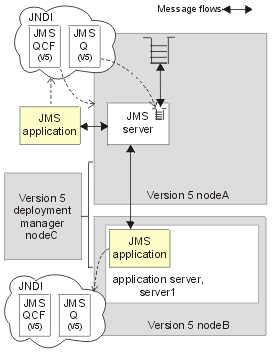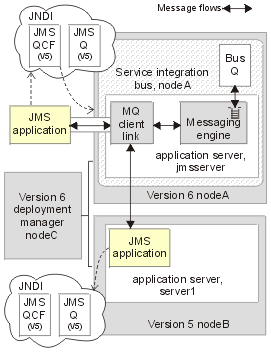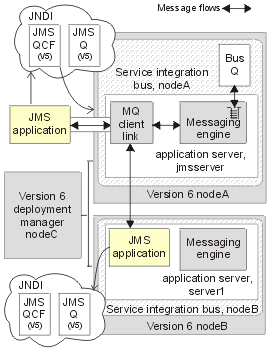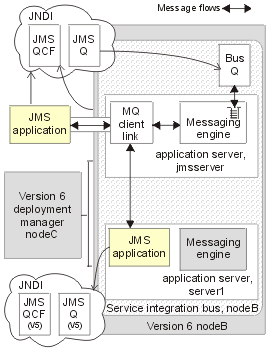 nodes to WebSphere Application Server version 6. For more information about this scenario, see the text that accompanies this figure.">
nodes to WebSphere Application Server version 6. For more information about this scenario, see the text that accompanies this figure.">
This topic describes the migration of a network deployment environment from the embedded messaging in WebSphere Application Server version 5 to the default messaging provider in WebSphere Application Server version 6.
This topic provides the main steps, which are based on the general considerations given in General considerations for migrating from version 5 embedded messaging, and link to tasks that provide the detailed steps involved.
The main consideration is that when migrating a WebSphere Application Server version 5 node to version 61, you do not need to make any changes to JMS applications; they can continue to use their same deployment and installation, and their same configurations of version 5 JMS resources (with one exception below). Consider the basic network deployment scenario before migration, as shown in the following figure Figure 1.
Figure 1. WebSphere Application Server 5 network deployment JMS application scenario before migration .
This figure shows the example network deployment scenario before migrating any nodes to WebSphere Application Server version 6. The JMS application is supported by an application server running on nodeB, and uses JMS resources configured to use a JMS server on nodeA. The cell is managed by the deployment manager on nodeC. The JMS application could be running within the application server or as a JMS client application.
 nodes to WebSphere Application Server version 6. For more information about this scenario, see the text that accompanies this figure.">
nodes to WebSphere Application Server version 6. For more information about this scenario, see the text that accompanies this figure.">
To migrate a WebSphere Application Server network deployment environment from version 5 embedded messaging to the version 6 default messaging provider, complete the following steps:
The version 5 embedded messaging JMS resources in the deployment manager cell are renamed to
"V5 Default Messaging" JMS resources in WebSphere Application Server version 6. For example, on the WebSphere administrative console,
WebSphere JMS Provider >
WebSphere queue connection factories as shown in version 5 is renamed to
V5 Default Messaging >
WebSphere queue connection factories in version 6.
The JMS server is migrated to an application server, called jmsserver, and added as a member of a service integration bus that has the same name. A messaging engine is created automatically on that bus for the application server. There is only one such application server and bus for each version 5 node.
A default WebSphere MQ client link , called Default.MQClientLink, is created automatically for the node and assigned to the messaging engine for the application server called jmsserver.
For each JMS queue defined on the JMS server, the migration process automatically creates a new bus queue with the same name as the version 5 JMS queue, and creates a message point assigned to the messaging engine. Messages sent to the JMS queues are stored and processed at the message point. After migrating the deployment manager and JMS server nodes, the network deployment scenario becomes one of interoperation between version 5 and version 6 nodes within a version 6 deployment manager cell as shown in the following figure Figure 2.
Figure 2. WebSphere Application Server 5 network deployment JMS application scenario after migration stage 1 .
This figure shows the example network deployment scenario after migrating the deployment manager nodeC and the JMS server nodeA to WebSphere Application Server version 6. The version 5 JMS server has been recreated as a version 6 application server with a messaging engine in its own service integration bus, shown as bus nodeA. Also, a WebSphere MQ client link and bus queue have been created and assigned to the messaging engine, to enable version 5 JMS applications to use the JMS resources.

The interoperation between version 5 and version 6 nodes within a version 6 deployment manager cell is intended only as an intermediary stage toward a complete version 6 cell. In this scenario, to complete the migration you migrate the remaining application server nodeB.
After migrating all the nodes in the cell, the scenario then becomes as shown in the following figure Figure 3.
Figure 3. WebSphere Application Server version 5 network deployment JMS application scenario after migration stage 2 .
This figure shows the example network deployment scenario after migrating all the nodes
to WebSphere Application Server version 6, but before replacing version 5
JMS resources with equivalent version 6 JMS resources. The WebSphere MQ client link for the messaging engine on bus B enables JMS applications to use the version 5 JMS resources implemented by the version 6 default messaging provider.
 nodes to WebSphere Application Server version 6, but before replacing version 5 JMS resources with equivalent version 6 JMS resources. For more information about this scenario, see the text that accompanies this figure.">
nodes to WebSphere Application Server version 6, but before replacing version 5 JMS resources with equivalent version 6 JMS resources. For more information about this scenario, see the text that accompanies this figure.">
The JMS application can continue to access the version 5 JMS resources, which are now managed as V5 default messaging JMS resources implemented by the WebSphere Application Server version 6 default messaging provider. You can use the version 6 administrative console to manage the JMS resources as V5 default messaging JMS resources. There are two variants on this migration:
Figure 4. WebSphere Application Server version 5 network deployment JMS application scenario after migration of a combined JMS server - application server node .
This figure shows an example network deployment scenario after migrating the deployment manager nodeC and a server node that hosts both a JMS server and application server. The version 5 JMS server has been recreated as a version 6 application server with a messaging engine in its own service integration bus, shown as bus nodeB. Also, a WebSphere MQ client link has been created for the messaging engine on bus nodeB, to enable version 5 JMS applications to use the JMS resources implemented by the version 6 default messaging provider.

You should replace the V5 default messaging JMS resources with equivalent version 6 default messaging provider JMS resources as soon as is conveniently possible (after all JMS applications using those resources have been moved onto WebSphere Application Server version 6).
You should define any new JMS resources as version 6 resources.
Parent topic: Migrating from version 5 embedded messaging
Related reference
General considerations for migrating from version 5 embedded messaging
1 To make reading easier in this topic, the abbreviation
"version 5" is sometimes used to refer to
"WebSphere Application Server version 5" and
"version 6" is used to refer to
"WebSphere Application Server version 6" . For example,
"version 5 JMS resources" refers to JMS resources